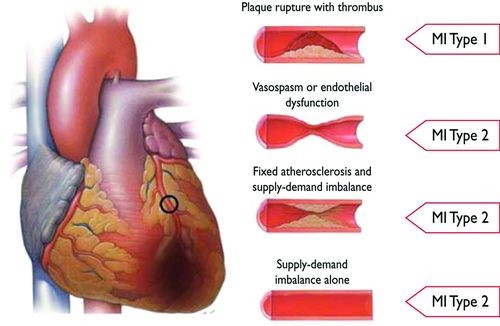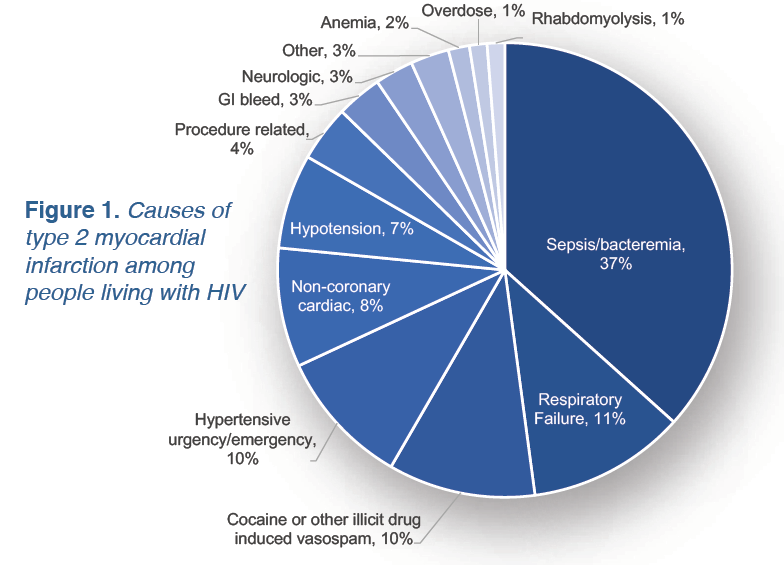A Tale of Two Heart Attacks

Differentiation between Type 1 and Type 2 heart attack according to the condition of the coronary arteries (Thygesen, et al., 2012, Circulation)
Crushing. Stabbing. Gut-wrenching, knock the wind right out of you sort of pain in your chest, arms, neck, jaw or back. This is how we commonly think of heart attacks and for patients and their loved ones – it is the worst of times. But just before the pain or discomfort starts, your body is adjusting to the cause of the heart attack and those causes can be classified as either Type 1 or Type 2 heart attacks. There are actually 6 types of heart attacks, but the vast majority of heart attacks, including those experienced by people living with HIV, are either Type 1 or Type 2.
A Type 1 heart attack is when a person has a sudden block in their blood flow, usually related to a blood clot that has broken off from a plaque, resulting in reduced oxygen going to the heart and death of heart muscle cells. Whereas a Type 2 heart attack is when the heart needs more oxygen than it gets, due a number of potential causes including a spasm of the heart vessels, critical illness (including sepsis, very low blood pressure, and respiratory failure), or those undergoing surgery.
As I’ve previously written, HIV doubles the risk of heart disease and doubles the risk of having a heart attack. But in order to understand how to reduce this risk, we need to better understand what causes heart attacks in people living with HIV. Building on previous work demonstrating that half of the heart attacks in people living with HIV are Type 2 heart attacks, Crane and colleagues recently presented new research on the differences in types of heart attacks among people aging with HIV. In over 27,000 adults living with HIV, the investigators determined the type of heart attack, probable cause of all Type 2 heart attacks, and looked at the rates of heart attack by age.
 They identified over 1,000 Type 1 and 2 heart attacks and found that age was a primary predictor of the incidence and type of heart attack. Younger people with HIV had 10-fold more Type 2 than Type 1 heart attacks (although rates were low – only 22 heart attacks in this age group). Starting in their 50’s, people living with HIV experienced significantly more Type 1 heart attacks than Type 2. Most interestingly were the heterogeneous causes of the Type 2 heart attacks including sepsis, respiratory failure, pneumonia, hypertensive emergency, and GI bleeds (Figure 1).
They identified over 1,000 Type 1 and 2 heart attacks and found that age was a primary predictor of the incidence and type of heart attack. Younger people with HIV had 10-fold more Type 2 than Type 1 heart attacks (although rates were low – only 22 heart attacks in this age group). Starting in their 50’s, people living with HIV experienced significantly more Type 1 heart attacks than Type 2. Most interestingly were the heterogeneous causes of the Type 2 heart attacks including sepsis, respiratory failure, pneumonia, hypertensive emergency, and GI bleeds (Figure 1).
When asked what initially prompted this work, Dr. Heidi Crane from the University of Washington Center for AIDS Research states, “As an awareness of the importance of Type 2 heart attacks has grown in the general population, we were struck that there was so little data in people living with HIV- a population which has twice the rate of heart attacks as the general population.” This new study demonstrates that younger adults living with HIV are more likely to have Type 2 heart attacks from heterogeneous causes, which change the prevention strategies needed for this group. While prevention strategies for Type 1 and 2 heart attacks require attention to traditional risk factors, we also need to pay attention to other non-traditional causes that may put someone with HIV at risk for heart attack due to supply-demand mismatch. Ultimately, these prevention strategies will need to be as heterogeneous as the causes. Dr. Crane continues, “There’s not going to be an easy fix for Type 2 heart attacks, there’s a lot going on and we will need to dive deeper to understand how to best tailor strategies to the individual patient.”
And yet, we’re often told that we need to treat the patient, not the disease. But in order to treat the patient, we have to know them, listen to them and understand the risk factors that they face as individuals for heart attacks. Whether it is a chronic disease like HIV infection or some other inflammatory condition, we will need to avoid the temptation to apply blunt prevention strategies, and favor the more challenging personalized solutions.
What are your experiences diagnosing and treating Type 2 Heart Attacks? How can we do a better job preventing them in people living with HIV and others at high risk? Tweet at me at @AllisonWebelPhD to follow the conversation.

Thumbnail photo credit: Photo by Kelly Sikkema on Unsplash